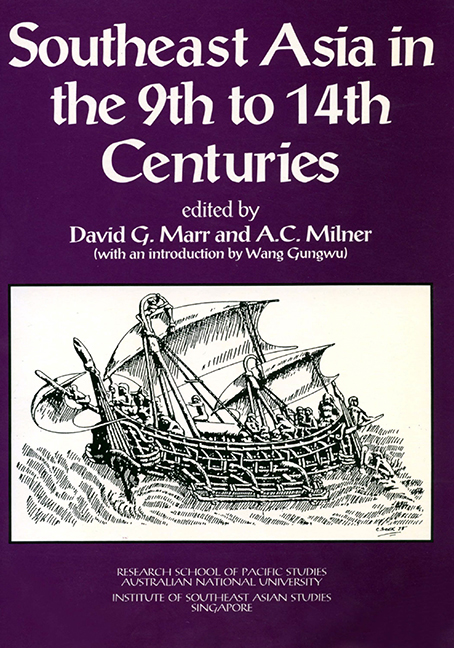Book contents
- Frontmatter
- Contents
- Contributors
- Preface
- Introduction
- 1 The Early and the Imperial Kingdom in Southeast Asian History
- 2 Hydraulic Works and South East Asian Polities
- 3 Some Notes on Relations between Central and Local Government in Ancient Java
- 4 Negara, Mandala, and Despotic State: Images of Early Java
- 5 Some Remarks on Early State Formation in Cambodia
- 6 “Elephants Can Actually Swim”: Contemporary Chinese Views of Late Ly Dai Viet
- 7 Authority and Legitimacy in 11th Century Vietnam
- 8 From Myth to History: Imagined Polities in 14th Century Vietnam
- 9 Shipshape Societies: Boat Symbolism and Political Systems in Insular Southeast Asia
- 10 Changing Perspectives in Island Southeast Asia
- 11 Political and Cultural Continuities at Dvaravati Sites
- 12 The True and the Corbel Arch in Mainland Southeast Asian Monumental Architecture
- 13 Vietnamese Ceramics and Cultural Identity: Evidence from the Ly and Tran Dynasties
- 14 Traditions, Acculturation, Renovation: The Evolutional Pattern of Vietnamese Culture
- 15 Symbolism of Kingship in Arakan
- 16 Buddhism in Champa
- 17 The Ordering of Generations: Change and Continuity in Old Javanese Kinship
- 18 Sources on Economic Activities in Khmer and Cham Lands
- 19 Narrative Bas-Reliefs at Candi Surawana
- 20 Possibilities for a Reading of the 1293-1357 Period in the Vietnamese Annals
- Index
- Miscellaneous Endmatter
Preface
Published online by Cambridge University Press: 21 October 2015
- Frontmatter
- Contents
- Contributors
- Preface
- Introduction
- 1 The Early and the Imperial Kingdom in Southeast Asian History
- 2 Hydraulic Works and South East Asian Polities
- 3 Some Notes on Relations between Central and Local Government in Ancient Java
- 4 Negara, Mandala, and Despotic State: Images of Early Java
- 5 Some Remarks on Early State Formation in Cambodia
- 6 “Elephants Can Actually Swim”: Contemporary Chinese Views of Late Ly Dai Viet
- 7 Authority and Legitimacy in 11th Century Vietnam
- 8 From Myth to History: Imagined Polities in 14th Century Vietnam
- 9 Shipshape Societies: Boat Symbolism and Political Systems in Insular Southeast Asia
- 10 Changing Perspectives in Island Southeast Asia
- 11 Political and Cultural Continuities at Dvaravati Sites
- 12 The True and the Corbel Arch in Mainland Southeast Asian Monumental Architecture
- 13 Vietnamese Ceramics and Cultural Identity: Evidence from the Ly and Tran Dynasties
- 14 Traditions, Acculturation, Renovation: The Evolutional Pattern of Vietnamese Culture
- 15 Symbolism of Kingship in Arakan
- 16 Buddhism in Champa
- 17 The Ordering of Generations: Change and Continuity in Old Javanese Kinship
- 18 Sources on Economic Activities in Khmer and Cham Lands
- 19 Narrative Bas-Reliefs at Candi Surawana
- 20 Possibilities for a Reading of the 1293-1357 Period in the Vietnamese Annals
- Index
- Miscellaneous Endmatter
Summary
In May 1984, about forty historians, epigraphers, archaeologists, linguists and anthropologists convened at the Australian National University for four days to talk about early Southeast Asia. It was a refreshingly cosmopolitan encounter, at least four languages being spoken across the conference table, another six cropping up in the conference papers.
The outcome might have been a Southeast Asian tower of babel, with each specialist talking past the others. Fortunately, most participants came to Canberra eager not only to present the fruits of their most recent research, but also to evaluate the state of the field in general, and to engage in interdisciplinary and cross-regional discourse. To encourage such exchanges, conference organizers insisted that authors remain silent while their papers were introduced and reviewed by participants who were not specialists in the particular subject matter. Thus, a Javanist reviewed a paper on early Vietnam, a Malay specialist reviewed a paper on Arakan. Of course, authors took part in subsequent discussion and were permitted the final word. On the first morning some participants regarded the method with a certain trepidation, but by lunchtime it was clear we had an intellectually stimulating atmosphere in which the research materials themselves were being subordinated to the issues raised and the problems demanding further investigation. Towards the end of proceedings a number of scholars commented on how they had gained a better conceptual context for their own highly specific work.
Fortunately this spirit did not dissipate when scholars returned home, and has been captured in the revised papers published in this volume. Readers not familiar with the early history of the region will discover that Southeast Asia was a lively place in the ninth to fourteenth centuries, with extensive trade, bitter wars, kingdoms rising and falling, ethnic groups on the move, impressive monuments being constructed, and profound religious issues being debated. Readers vaguely aware of such grand Southeast Asian kingdoms as Angkor, Pagan, Majapahit, Champa or Dai Viet will see them take on colour and character. On the other hand, readers already well versed in the available literature will find that a number of contributors to this book are uncomfortable with established labels, asking whether they oversimplify reality, or obscure important developments elsewhere in the region.
To push deeper and wider in early Southeast Asian history demands discussion of specific texts, authors, artefacts and concepts.
- Type
- Chapter
- Information
- Southeast Asia in the 9th to 14th Centuries , pp. ix - xPublisher: ISEAS–Yusof Ishak InstitutePrint publication year: 1986



